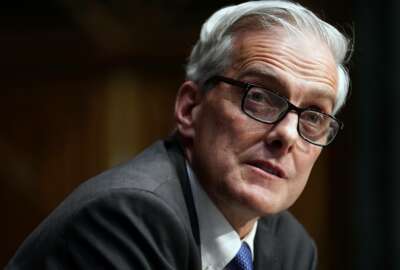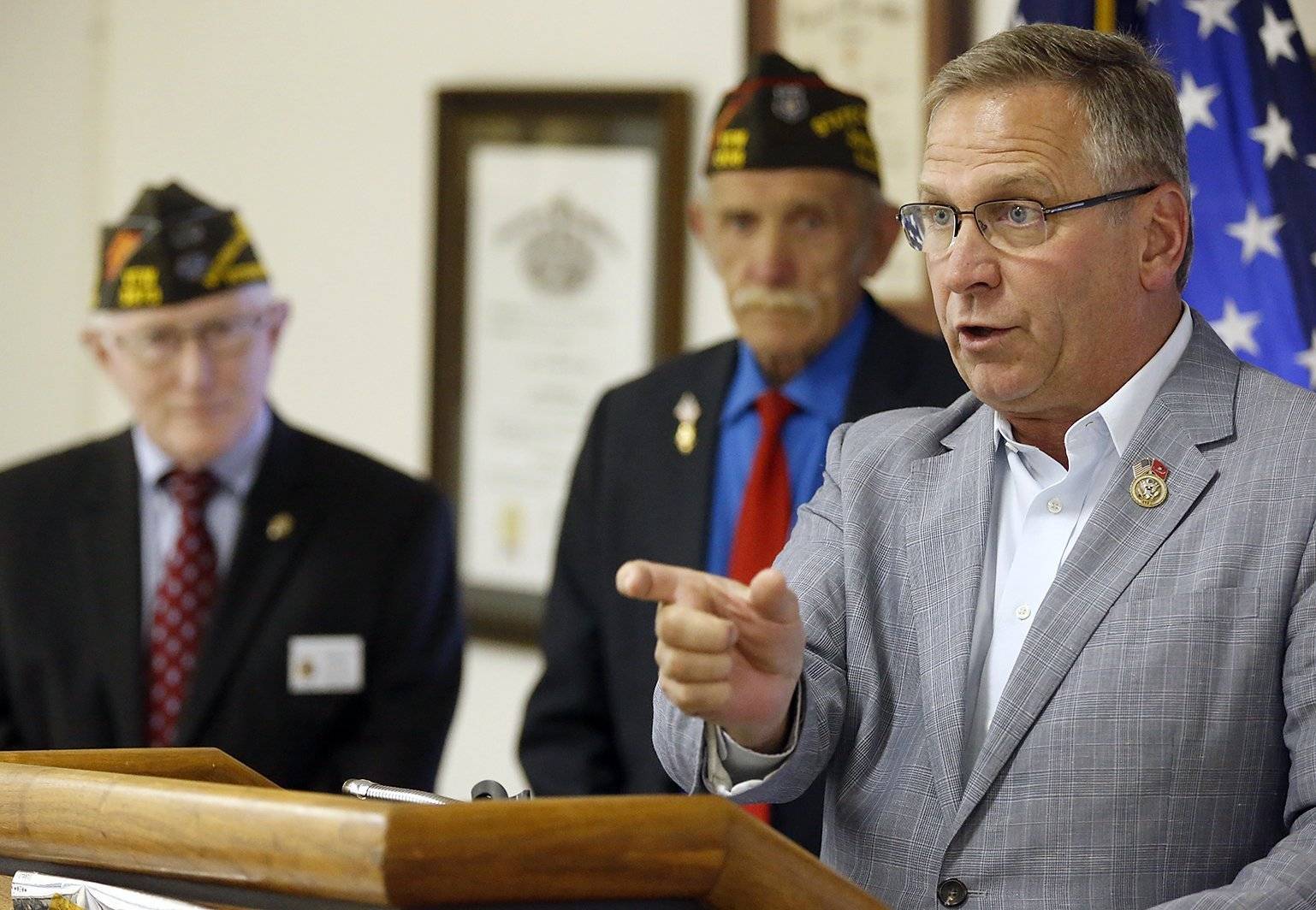

The Veterans Health Administration will hold a national onboarding surge event in November to get candidates who have already accepted job offers to start work...
Best listening experience is on Chrome, Firefox or Safari. Subscribe to Federal Drive’s daily audio interviews on Apple Podcasts or PodcastOne.
The Department of Veterans Affairs hired more employees in fiscal 2022 than at any point in recent history.
But top VA officials say more action is needed to build up the agency’s workforce, given a high rate of attrition and increasing healthcare demand from veterans.
VA Undersecretary for Health Shereef Elnahal told reporters Wednesday that the agency needs to hire about 52,000 employees per year just to keep up with the rate of health care workers leaving the agency, as well as an increase in veterans entering the VA health care system.
The Veterans Health Administration is addressing its workforce shortages, in part, by trying to bring new hires on board more quickly.
Elnahal said the VA will hold a “national onboarding surge event” the week of Nov. 14, as part of an “all-hands-on-deck” effort to get candidates who have already accepted job offers to start work sooner.
Elnahal said the VA is asking every facility in the country to submit a list of the highest-priority individuals that need to be brought on board as soon as possible, regardless of their position.
The event will bring together HR professionals, VA facility leaders and leadership in every Veterans Integrated Services Network (VISN) in the country to fast-track the onboarding of individuals who have already accepted a job offer from the VA.
“This event will be focused on the onboarding process, in particular after selection, because we know that comprises a significant timespan, even after selections are made. And we know that, to some frequency, we lose folks after we’ve made the selection, because of how long that can take,” Elnahal said.
Elnahal said the onboarding event will serve as a “national signal that we take this priority very seriously,” and will help set into motion end-to-end workforce and hiring initiatives laid out in the recently passed PACT Act.
“This will be not only a chance to have a step function improvement in the number of folks on board, which is an urgent priority, but to also set the groundwork for the more longitudinal work that we will need to do to improve the hiring process to improve our systems that our employees interface with, and ultimately to get more folks in the door as we proceed with this important priority,” Elnahal said.
VA Secretary Denis McDonough told reporters last month that July 2022 marked the first month this year that the VA hired more nurses than the number of nurses it lost to retirement.
“We have to do a better job on hiring,” McDonough said, adding that in many cases, the VA is taking 90-100 days to onboard candidates that have been selected to fill a position.
The Office of Personnel Management granted the VA emergency hiring authorities at the height of the pandemic that “allowed us to bring on clinicians and then work the rest of the onboarding process on the back end to meet that emergency need,” Elnahal said.
But despite VA’s earlier claims that the COVID-19 pandemic will “change the way we hire forever,” the agency is once again resuming lengthy onboarding processes now that some of those emergency authorities have lapsed.
“We are now in a much different place in the pandemic, and we are now working with a bulk of the processes, that we were able to skip in that emergency context before, to get folks on board,” Elnahal said.
The recently passed RAISE Act and the PACT Act give the VA tools to hire faster and more competitively, as well as compete with the private sector for in-demand health care workers.
The PACT Act expands VA’s authority to offer retention and recruitment bonuses, as well as student loan repayment for VA employees. The legislation also outlines steps to reform and standardize human capital functions across the agency.
“It is incumbent upon us to actually implement, to take advantage of those authorities, to the maximum extent in every corner of our system,” Elnahal said.
Once the PACT Act is fully implemented, Elnahal said the VA will talk with Congress about areas “where we see even more opportunities on expanding our ability to hire better.”
Elnahal said the VA has held many hiring fairs and surge events this year, and that VHA brought on more employees in fiscal 2022 than at any point in VA’s history, “but we still need to do more.”
“It’s still far and away among our first priorities. Because if we don’t get our hospitals and facility staff, it’s going to be a really hard effort to make process on the other priorities,” he said.
Meanwhile, the VA is sending letters to 41,500 veterans who may have been impacted by problems with the EHR currently running at five VA locations across the U.S.
The VA announced last week that the agency will push back upcoming deployments of its Oracle-Cerner EHR to June 2023 to address previously known and emerging problems with the system and to “make sure it is functioning optimally for veterans and for VA health care personnel.”
Elnahal said the population of veterans receiving letters hasn’t all necessarily had their health care impacted by the new EHR rollout.
“We are doing this out of an abundance of caution, this broad disclosure, to make sure that if a veteran identifies that they haven’t heard about a medication, or a laboratory study, or a radiology study that they know they need, they call us so that we can get to the bottom of that, even before we fix the system issues,” Elnahal said.
The letter tells veterans to reach out to the VA over the phone or online if they “experienced a delay in medications, appointments, referrals, or test results” at a facility using the Oracle-Cerner EHR.
“We are addressing each and every one of them, regardless of whether it’s related to the EHR. Because each of those instances is an opportunity to do right by veterans and to respond to their needs,” Elnahal said.
The VA is specifically addressing an “unknown queue” issue documented by the VA inspector general’s office that has led to thousands of clinical orders disappearing in an unmonitored inbox, causing patients to miss follow-up care.
Elnahal said the agency is looking more broadly at the possibility of unknown EHR issues over the next six to eight months.
“We are going to be looking at the possibility of what we don’t know yet in terms of this broader phenomenon across this six to eight-month period. In other words, we’re going to be doing assessments that involve technological observations of how commands get from one place to the other,” he said.
Elnahal said VHA patient safety teams will conduct a root-cause analysis for any “outcomes or deaths that were unexpected” at its facilities, and whether those incidents had anything to do with EHR problems.
While the EHR rollout has raised some concerns from Congress and the VA’s inspector general’s office, Elnahal said he’s optimistic that the Oracle-Cerner system “can work for the VA,” Elnahal said.
“The veterans who are getting care at the five facilities where this system exists now need a resolution to the configuration issues that have led to this disclosure. We’ve determined that the fastest way to address those risks is to work on the system, and reconfigure it and fix those issues where that system exists. I believe that, by extension, if we do that, this will be a system that will be ready to deploy elsewhere,” Elnahal said.
The Cerner EHR system is used by private sector health care market providers, as well as the Defense Department and Coast Guard.
“It is working in DoD. They’ve gone through their own journey and implementation and their own pauses to be able to make the system run better, and we need to do the same. I think that the system can ultimately work, but we need to make it work, and that’s what is happening in these next six to eight months,” Elnahal said.
Resumed rollouts of the EHR will also fall in line with what Elnahal described as VHA’s “journey to high reliability,” and a “commitment to zero harm.” He said the agency is specifically directing frontline to notify leadership if they “see any safety vulnerability that may befall our veterans.”
“My commitment is to resource it better and accelerate those efforts. Because where you see isolated instances of quality and patient safety issues, having that safety culture is the first step in leading to the necessary improvement,” Elnahal said.
The VA, meanwhile, is going back to the drawing board on plans to reshape its real estate portfolio of health care facilities.
The VA is pursuing an alternative strategy to rethink its real-estate needs for health care facilities after lawmakers scuttled the Asset and Infrastructure Review (AIR) Commission process, as envisioned under the MISSION Act.
A bipartisan group of a dozen senators in June put out a statement rejecting the VA’s plan to close or overhaul hospitals and medical facilities that no longer meet the health care needs of veterans.
McDonough said last month that the AIR Commission process, as envisioned under the MISSION Act, “will not go forward, as far as I can tell.”
Elnahal said the VA is updating the market assessments that served as the foundation for its AIR Commission recommendations and using more up-to-date data that takes into account the COVID-19 pandemic’s effects on the VA health care system
Elnahal said the VA is also taking a “bottom-up process” to determine the agency’s new infrastructure needs, based on input from facility leaders, veteran service organizations and other veteran advocacy groups in every local market.
“This is going to be a diligent process that’s going to start over, because we think it needs to start over. Trends have changed significantly since the pandemic,” Elnahal said.
The average age of VA hospitals and clinics is 60 years, which far exceeds the average of private sector health care facilities.
“We need modern facilities that are able to accommodate the best and newest technology available to patients across the country. That’s what our veterans deserve from our brick-and-mortar infrastructure. So it’s a process that absolutely still needs to take place,” Elnahal said.
Copyright © 2025 Federal News Network. All rights reserved. This website is not intended for users located within the European Economic Area.
Jory Heckman is a reporter at Federal News Network covering U.S. Postal Service, IRS, big data and technology issues.
Follow @jheckmanWFED



